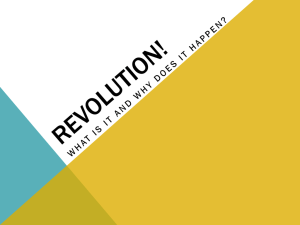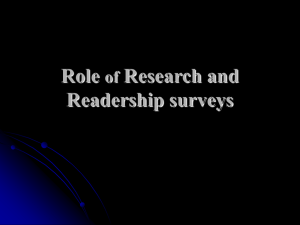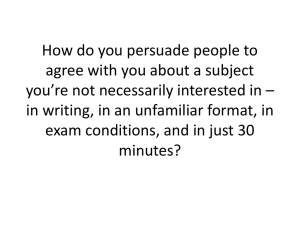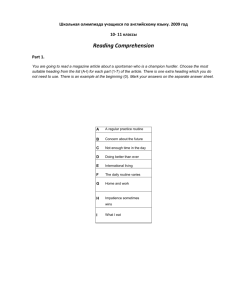Communication Hurdles: Challenges and Solutions
advertisement
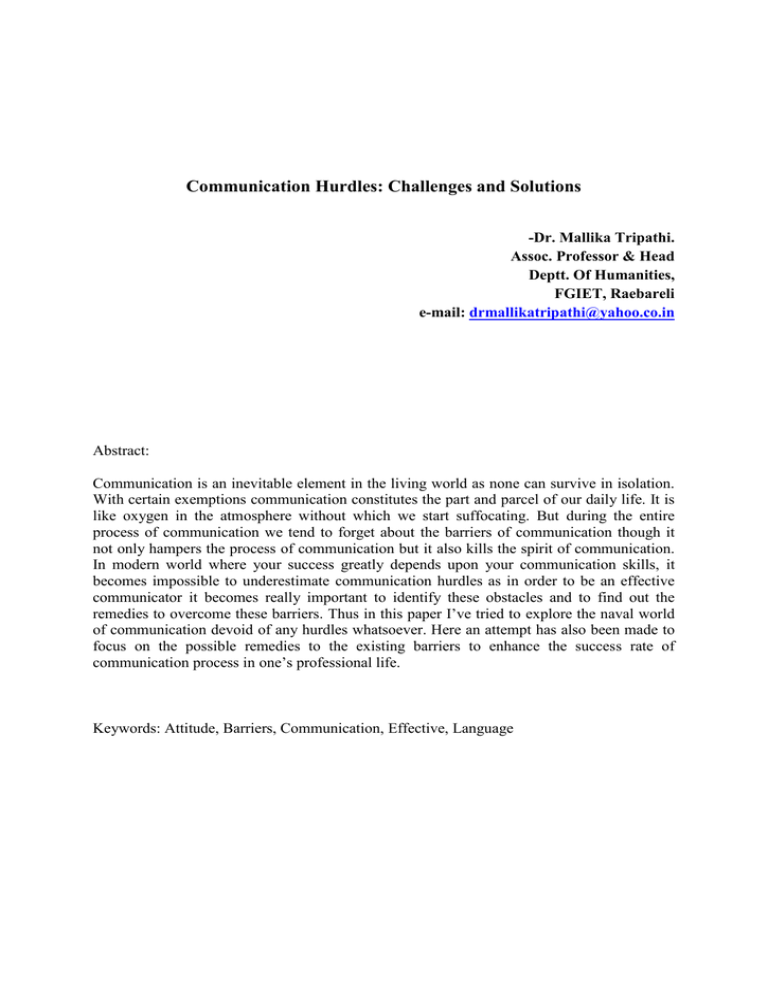
Communication Hurdles: Challenges and Solutions -Dr. Mallika Tripathi. Assoc. Professor & Head Deptt. Of Humanities, FGIET, Raebareli e-mail: drmallikatripathi@yahoo.co.in Abstract: Communication is an inevitable element in the living world as none can survive in isolation. With certain exemptions communication constitutes the part and parcel of our daily life. It is like oxygen in the atmosphere without which we start suffocating. But during the entire process of communication we tend to forget about the barriers of communication though it not only hampers the process of communication but it also kills the spirit of communication. In modern world where your success greatly depends upon your communication skills, it becomes impossible to underestimate communication hurdles as in order to be an effective communicator it becomes really important to identify these obstacles and to find out the remedies to overcome these barriers. Thus in this paper I’ve tried to explore the naval world of communication devoid of any hurdles whatsoever. Here an attempt has also been made to focus on the possible remedies to the existing barriers to enhance the success rate of communication process in one’s professional life. Keywords: Attitude, Barriers, Communication, Effective, Language Communication is an initiation; an initiation for a long lasting rapport to be cherished forever. But it all depends upon the communicator whether he succeeds to develop this bond or it turns out to be short term progression that utterly results in a fiasco. Communication can make relations if it is completed successfully and it can break relations if the process gets hampered due to one or the other reason. Communication in an organization is of paramount importance as the sole progress of an organization depends upon its communication process. It might include internal operational, external operational or personal communication among employees within premises. Owing to its importance an analysis of communication hurdles becomes too important in this context. Cambridge Dictionary defines barrier as ‘anything that prevents people from being together or understanding each other.’ Thus barriers to communication may refer to any disturbance or noise in the channel that hampers the process of communication. There exist umpteen barriers to communication that might occur at any stage in the communication process. Barriers may distort a message and therefore result in communication failure. It is also known as communication hurdles. Here hurdles refer to any obstacle that prevents the natural flow of communication. Although effective communication does not guarantee success but its absence certainly ensures the failure. Communication hurdles involve a no. of factors including physical, emotional, cultural, social and educational, resulting in the failure of communication process. Recognizing barriers is of utmost importance as the purpose of communication will be defeated unless we take adequate measures to remove these barriers. Much has been written about Barriers to communication but this paper is mainly concerned with barriers that affect our efficiency in professional life and play a vital role in spoiling the work culture of an organization thus resulting in fiasco of the entire system. Here we will critically examine the specific hurdles to communication that adversely affects the overall growth of an organization: 1. Technological Barriers 2. Mental phobia 3. Biased approach 4. Misrepresentation of facts 5. Semantic barriers 6. Use of abbreviations 7. Para verbal barriers 8. Non verbal communicative barriers 9. Wrongly chosen medium 10. Hectic schedule 11. Multiple links 12. Faulty system 13. Cultural Difference 14. Psychological and physiological barriers The term Barriers can be better understood in context with sender, receiver and the medium of communication as these are the major constituents of communication process. A recent survey that included 100 employees revealed the surprising fact that Organizational Barrier had been the major concern for failure in Professional communication. Intrapersonal Barriers had been another major issue followed by Semantic and Non Verbal Barriers consequently: Communication Hurdles Intrapersonal Barrier organisational barrier Semantic Barrier Non verbal Barriers Now we will continue with the critical analysis of different communication hurdles as identification of these barriers remain to be really important to formulate strategy for effective communication: 1. Technological barriers: Today we live in a tech savvy world where survival becomes next to impossible without appropriate knowledge of technology. Apt use of technology in professional domain add luster to our working. On the contrary lack of technical skills leaves us nowhere. With the rapid rising in the field of technology it becomes important to have up to date information of technological advancement else we would fail to communicate with others e.g. It’ll not be possible for a professional to give effective presentation without technical aid. So if one fail to have the knowledge of latest technology like MS Word, Power Point Presentation and so on it’ll certainly be difficult for him to communicate effectively in spite of his rigorous working. 2. Mental Phobia: This is truly said that ‘Fear kills the spirit of communication.’ None can speak his heart if he suffers from the fear syndrome. We often come across people who fail to communicate their ideas because of the fear of influential people. For example Mr. Ram, the Unit Head, might be too genuine in his approach but due to the fear of his Union leaders (as they might go on strike affecting the production of the company) he might not willing to discuss certain urgent issues with his workers. Similarly so many times we see people who fail to communicate the actual facts due to the fear of their superiors resulting in nodding their head even for wrong practices. This sort of mental phobia greatly hampers the natural flow of communication. 3. Biased approach: Communication process consists of two parties Sender and the Receiver. Both carrying the equal importance but if one is adamant not to comprehend the actual facts nothing can be done as prejudiced people deny to listen what they don’t want to listen and vice versa one might not communicate the true facts if he is biased about a certain person. Thus it acts as a mental block that greatly affects the process of communication. 4. Misrepresentation of facts: Mr. XYZ might distort the actual message if it is not in accordance with his expectation thus misrepresenting the facts for his own benefit. This sort of unethical practices where people hide some information or misrepresent the information for individual gain acts as a barrier to communication. Sometimes overambitious people use this as a tool to hype their progress chart in order to gain untimely promotion or other advantages. 5. Semantic Barriers: Semantic barriers refer to the process of wrong coding and decoding due to various factors. Use of technical jargons, similarly pronounced words (having multiple meaning), wrongly interpreted communication fall under this category. Thus a meaningful distinction becomes mandatory between inferences and facts to avoid any sort of miscommunication. 6. Use Of abbreviation: Use of abbreviations creates a major hindrance in communication process. In the modern world where use of e-language is increasing rapidly it becomes very important to opt for clarity in expression and thought or it might result in wastage of time and sheer failure of communication process. It can be understood through following example: Ramesh: I want to take PC. Prem: Mr. Singh can help as he is Professor of PC. Ramesh: What? Professor of PC? Prem: Yes, he is too apt in his skills. Ramesh: oh! can you tell me the price? Prem: Price for what? Ramesh: Price for the latest PC. Prem: Professional Communication is a subject and Mr. Singh is an honorary Professor. Ramesh: What’s wrong with you I’m talking about buying Personal Computer? Prem: !!!!!!!!!!!!! 7. Para verbal barriers: Para verbal barriers coveys an indirect message to the receiver. It refers to the message that is transmitted through pitch, tone, voice and so on. For example while initiating a conversation if one opts for high pitch with a different tone (different from usual) it acts as an indication that one is not in a mood to converse. Generally influential people opt for these tactics to avoid a conversation on a particular topic. Professor Mehrabian states that, ‘the Para-verbal message accounts for approximately 38% of what is communicated to someone.’ One may convey entirely different meaning through a sentence while changing his pitch, tone and voice. 8. Non verbal communicative barriers: Someone has rightly quoted, ‘You speak through your eyes.’ Yes the effect of non verbal communication can’t be denied. It plays a vital role in motivating or de motivating a speaker to communicate. Professor Mehrabian in his book, Silent Messages, clearly indicates that ‘the message we send through our posture, gestures, facial expression, and spatial distance account for 55% of what is perceived and understood by others.’ Thus non verbal cues greatly affect the process of communication. You unintentionally may signal a negative vibe through your facial expression resulting in the failure of communication. 9. Wrongly chosen medium: Using an inappropriate medium to convey information can be very harmful. Today we use different mediums to communicate our ideas e.g. flow chart, e-mail, telephone, slides, tables, graphs etc. So while choosing these medium analyzing certain factors become really important else it might result in complete fiasco of communication process. For example if you wish to address illiterate people use of flow chart, graph will not be of great help rather it would be better to simplify your message using the language of targeted audience. Similarly if you need to communicate someone abroad, e-mail is better than writing a letter as the later might delay the process of communication. 10. Hectic schedule: Now a day people lead a hectic life that often results in communication failure. Being overworked up people fail in effective communication as most of the time they get lost in handling a large no. of data and information thus resulting in overall degradation of quality work. So many times it results in failure of timely communication as one fails to communicate effectively and on time due to his/her busy schedule. 11. Multiple links: Due to the involvement of a no. of people the information often gets distorted. Sometimes the persons involved in the process of transfer also manipulate the actual message for their own benefit. For example: Mr. Sharma( to Mr. Pandey): Tell Mr. Maurya to ensure his presence on 14th August at around 1:00 pm for an urgent meeting. Mr. Pandey( to Mr. Dixit): Could you please convey Mr. Maurya to be present on 14 th August at 1:00 pm for a meeting. Mr. Dixit( to Mr. Murya): Perhaps there is a meeting if you are comfortable just be there on 14th August at 4:00 pm. Thus multiple links in information transfer might destroy the actual message resulting in failure of communication. 12. Faulty System: It refers to the specific problems with the structures or systems of an organization. For example an organizational structure that is unclear results in sheer confusion of people to know whom to communicate with. Other examples could be inefficient or inappropriate information systems, a lack of supervision or training, and an ambiguity in roles and responsibilities of employees that can lead to chaos and confusion in an organization. 13. Cultural differences: Differences in culture is one of the major hurdles to effective communication. As per Hindu culture the females of a family are supposed to be reserved while interacting socially. Even Muslim culture does not allow females to be too intimate with others. On the contrary in western countries there are no restrictions as such. So when people from different cultural background meet, overall process of communication gets hampered due to their social and cultural difference. 14. Psychological and Physiological barriers: Mental and physical state of a person also affects his communicating ability. This acts as one of the chief barriers that not only hinders the flow of communication but also results in failure of communication process. For example if someone is over occupied with his personal problems like family, marriage, finance or so on he’ll never succeed to communicate effectively. Even the physiological problems like ill health, poor eye sight and hearing problems will certainly affect his efficiency as a communicator. Suggestions to overcome communication hurdles in professional domain: In order to facilitate effective communication removal of communication hurdles become too important. Following suggestions may help one to overcome the most arduous barriers of communication: 1. Proper training program should be initiated to help the professionals. They should be trained in such a way so that they succeed in keeping pace with the current technological trends. 2. Healthy interaction should be promoted in an organization to develop harmony among fellow workers. Besides they should also be encouraged to come out of their fear zone to interact freely with the management. 3. One should work ethically. Instead of being prejudiced or partial it’s better to work for mutual growth. Thus rewarding fair people can be a good idea to spread the message of impartial and unbiased communication. Strict action should be taken against those who are found involved in mal practices. 4. While communicating with others one should opt for clarity of thoughts and expression. Instead of using abbreviation or ambiguous words one should focus on direct and clear communication. 5. One needs to be balanced in his approach as unknowingly one might be discouraging others to communicate and in case of troublesome situation the message should clearly be communicated so that it does not affect the natural flow of communication. 6. Discouraging people through non verbal cues is not a good idea irrespective of the fact if it is done intentionally or unintentionally as it might affect the spirit of free communication. Here focus should be on providing open communication environment. 7. One should not communicate while being mentally disturbed as it might result in communication failure. Thus it is advisable to maintain one’s composure while communicating with others. 8. Communication inadequacy due to cultural and language difference is a major concern thus having adequate knowledge of others’ culture before communicating can be of great help as it will result in successful communication and a healthy bond. 9. Appropriate use of communication channel is of utmost importance as it will affect the entire communication process. So one must opt for the exact medium as per the requirement of the communication. 10. In professional environment quality should be focused than quantity. Instead of winding up in a hurry one should take sufficient time to manage the information and to give the best in terms of efficient communication. 11. Direct communication is always preferred over communication through various transfer stations. Where direct communication is not possible one should take preventive measures to avoid any sort of miscommunication. 12. In order to make communication a success one should always take feedbacks so that the pros and cons of a situation can be well analyzed and immediate measures can be taken to curb any adverse situation that could hamper free flow of communication in an organization. In addition to the removal of specific barriers to communication, the following general guidelines may also facilitate communication: 1. One should always communicate with a positive attitude. 2. We need to constantly improve our communication skills. 3. Communication skills must be judged at the time of recruitment. 4. Focus should be on free flow of communication and a healthy attitude towards fellow employees. 5. Communication plays a vital role in developing harmony among employees that remains to be soul of success thus it should not be taken lightly. 6. Organising communication workshops or programs can be of great help as it will create awareness among workers giving them a platform to share their thoughts in public forum. Conclusion: Communication is at the heart of many interpersonal and organisational problems faced by the employees and employers. Understanding the communication hurdles and then working at improvement strategies provide a formula for becoming more effective communicators. Analysing the common barriers to communication is the first step to minimizing their impact. As soon as one succeeds in winning over these obstacles an eternal gate of success opens up to be cherished forever. References: Koneru, A. “Professional Communication.” McGraw Hill Pub. New Delhi, 1998. Print Raman M. & Sharma. “Technical Communication.” OUP, New Delhi, 2007. Print Mitra B.K. “Effective Technical Communication,” OUP, New Delhi, 2006. Print
